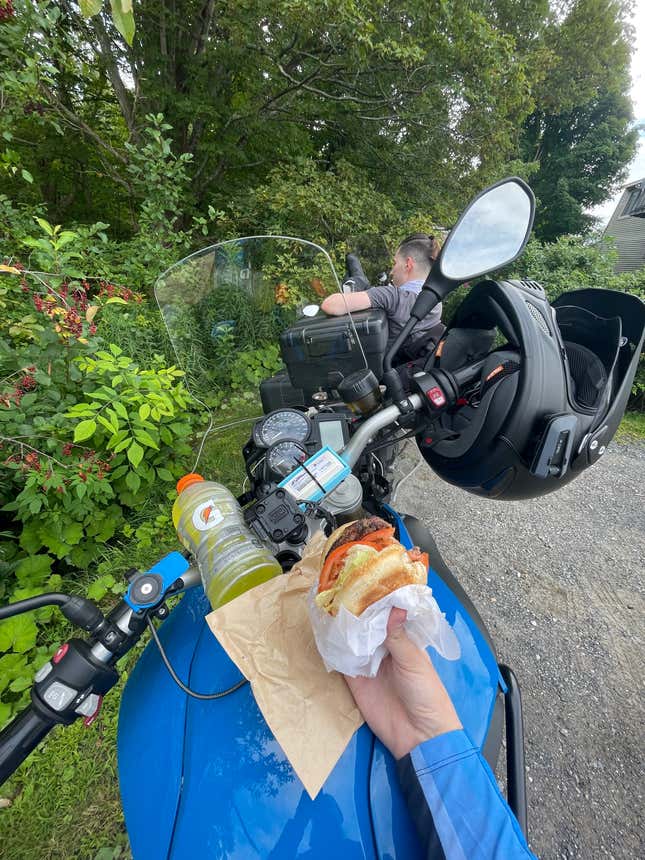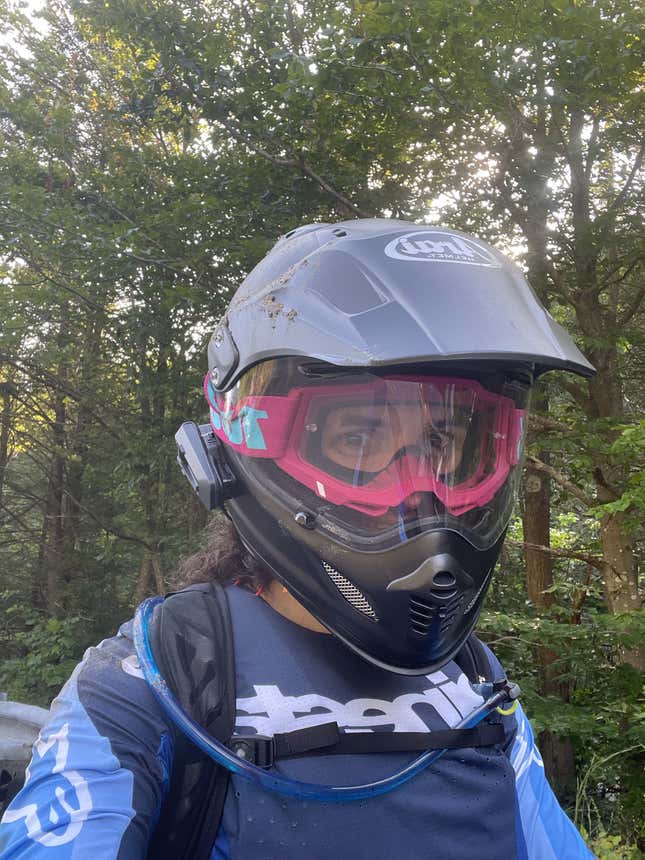Dirt Gear Or Adventure Gear: Which Is Right For Your Ride?

Back in August, I took a 90-odd mile mixed-surface motorcycle trip with a friend. Since we were both riding near-identical BMW F800GSs, it seemed like a fun chance to do some comparisons — hard luggage or soft, cell phone or GPS, and perhaps most importantly: Should you do your mixed-surface ride in fancy ADV gear or cheap dirt armor?
I Need To Replace My Dying Volkswagen | What Car Should You Buy?
Adventure gear is high-tech, cutting edge, and built for the harshest Starbucks trips imaginable. Dirt gear, by contrast, is cheap, simple, and reliable — your average MX-owning teenager isn’t exactly filtering their search results for Gore-Tex. But when your trip involves streets and dirt, sun and rain, highways and mud pits, which approach comes out ahead?
Full Disclosure: The kind folks at Alpinestars fully kitted out both me and my friend Graham for this trip. I’ll go into the specifics of the gear in each section down below, but suffice to say it wasn’t an inexpensive collection of pieces.
Two approaches to adventure diverge in a yellow woodPhoto: Steve DaSilva / Jalopnik
The Adventure Gear
Most adventure motorcyclists, with their Long Way dreams and Starbucks realities, will default to buying adventure (if not outright street) protective gear. It looks the part — serious, rugged, yet technical enough to work in nearly any situation — and if they’re lucky, they can even get branded apparel that matches their bike. Adventure motorcyclists love nice branding.
Cheap shots aside, though, ADV gear makes sense for ADV motorcyclists — if not all motorcyclists. It’s usually heavily armored yet heavily vented, protective and comfortable in equal measure for long days on the bike no matter the season. At least, that’s the pitch. To find out if it’s true, I stuck a friend of mine in $1,380 worth of Alpinestars’ finest adventure gear.

This was our little area to rest, after we both crashed out in the mudPhoto: Steve DaSilva / Jalopnik
The Alpinestars gear for this trip started with the $320 Corozal Adventure Drystar boots. Moving up, Graham got a pair of $260 Andes V3 Drystar pants, and topped everything off with an $800 AMT-10 Drystar XF jacket. Motorcycle gear is rarely cheap, but nearly $1400 still sets a high expectation — for that money, the kit better be damn good.
For the most part, it is. Graham was impressed by the gear’s fit over his lanky frame, and by the sheer amount of technicality the garments offered — vents, pockets, and thermal layers abound. ADV gear is meant to do everything, to work in every situation, and this getup does just that. It could easily be the only set of jacket, pants, and boots a rider owns, and there’s nothing they wouldn’t be able to face.

Two of them (two of them)Photo: Steve DaSilva / Jalopnik
Just because a set of gear can do everything, though, doesn’t mean it’s ideal for every situation. This mixed-surface ride took place in New England’s August heat, and the Alpinestars gear — much of it in dark colors — ran hot. Sure, the jacket and pants were ventilated for comfort, but at the slow speed of a beginner offroad rider there isn’t much air working its way through the fabric.
This, too, is typical of ADV paraphernalia. It can’t be fully mesh for airflow, because its do-everything nature demands warmth and waterproofing. Such protective garments, all leather and armor, are also known to weigh riders down — making you more tired after a day of standing on the pegs. Additionally, for the pants, Graham had one other notable complaint: “Very loud and annoying to walk around in, so just ride your motorcycle around indoors instead.”

Turns out, the shape of torso armor is incredibly flattering under a jerseyPhoto: Graham Boylan
The Dirt Gear
While adventure gear is expensive, full-featured, and suitable for all tasks, dirt gear is the opposite. It’s cheap, light, and single-purpose, meant to keep you safe and cool while bombing trails on a YZ125. At first glance, it seems to solve the problems inherent to adventure gear.
In doing so, though, it introduces new issues. Graham’s ADV gear was three pieces (boots, pants, jacket). I needed six separate bits of apparel to match: The $40 Bionic Plus Knee Protector, the $40 Bionic Plus Elbow Protector, the $180 A-4 Max Chest Protector, the $70 Techstar Pneuma Jersey and $195 Techstar Pneuma Pants (in blue, to match the bike, with the $45 Techstar Gloves completing the look), and my own personal $500 Sidi Crossfire 3 boots. That totals out to $1,070, though a fairer price comparison would probably use something like the $250 Tech 3 Boot to match the protection of the ADV-styled Corozal.

I carried a hydration pack all day, but there’s no such thing as too much hydration. Unless there is. I am not a doctor.Photo: Steve DaSilva / Jalopnik
One issue I assumed I’d encounter, though, turned out to be a complete red herring: Aesthetics. I figured that, for lunch stops and gas fillups, I’d get reactions similar to Marty McFly entering 1955 — while Graham, in simple ADV gear, would look like a regular human being. It turned out, though, that the all those vents and pockets and waterproof membranes start to take a toll on a garment’s appearance, and ADV gear looks equally motorcycle to people who don’t ride. In the end, we both received an approximately equal number of unnerved looks when we stopped at a small-town burger joint for lunch.
Away from civilization, however, the dirt gear really worked. I own plenty of motorcycle armor, and the dirt gear was lighter than anything I’d ridden in — technical adventure garments, high-temperature mesh, the dirt gear beat it all. Even with a hydration bladder and a camera on my back, jockeying my way around the bike was easy and comfortable. My boots, with their stiff hard armor and movement-limiting ankle hinges, definitely tried their best to inhibit that movement, but I’d buy them again. They’re the only piece of my kit that cost more than the commensurate piece of Graham’s, and they saved my ankle when I dropped my BMW on my leg during the ride.

Hopping back onto the bike, after a crash, was similarly easy. Physically, at least. The inner ear took a minute to catch up. Photo: Steve DaSilva / Jalopnik
That light weight helped keep temperatures down, too. The outer jersey material was nice and breathable, letting air flow through, and the targeted protection beneath meant there was little blocking that breeze from my skin. Small, separate armor pieces are a wonder for on-bike cooling, and a godsend in hot weather.
That targeted protection isn’t infallible, though. For one, it means strapping each bit of padding to yourself individually — by the time the ride was done, I had red marks where the knee pads and elbow armor had dug into my skin. Worse, still, targeted protection leaves you completely unprotected in all other areas. While an ADV garment will protect you from abrasion in between its armor pads, dirt gear offers no such quarter. Had I gone down on the blacktop during that ride, there would be nothing protecting my skin from the cheese grater-like asphalt.

Photo: Steve DaSilva / Jalopnik
The Verdict
Adventure gear is a jack of all trades that still masters many, but its capability comes at a paycheck-level price. Dirt gear is cheap, breathable, and protects you where it counts, but only does so from impacts — should you go for a slide, don’t expect a jersey to protect you from much. Both have their advantages, their flaws, and their specialities, so we return to the question that started us off: Which one should you buy? The final decision there lies with you and your riding preferences, but we can help make it easier.
If you have all the money in the world, and you’d rather spend the most sweltering days luxuriating in your marble pool than straddling a super-hot engine, ADV gear is a no-brainer. It’s perfect for three seasons out of the year, protects better than dirt gear, and lets you show up to Starbucks looking like a dentist rather than a dirt biking teen.
On the flipside, if you only touch the minimum tarmac necessary to get to your dirt trails, you’ll probably prefer the dirt gear. You’ll see the benefits of the lower cost and more dirt-focused protection, and that breathability will be a godsend as you muscle your bike between trees, mud, and the occasional bear. You’ll want to shell out on proper boots, though, with hard armor and hinged ankles that prevent your foot from twisting off in whichever direction it pleases.
If you ride a healthy mix, though, there’s a way to split the difference. It’s the method I chose for every part of this trip that wasn’t the dirt ride — I simply brought two sets of gear. In addition to the dirt armor and jerseys, I brought my regular riding jeans and mesh jacket. For the ride from New York to Massachusetts, and the ride back home, I was protected from both impacts and slides, and I didn’t have to sacrifice any comfort while out in the dirt. The only sacrifice I made was a bit of space in my bag.
The truly ideal solution isn’t any single garment that perfectly covers every use case — it’s two sets of armor. By swapping between dirt armor and street gear, you can always have protection catered to your specific needs rather than any jack-of-all-trades compromise. Play your cards right, acquire your armor piecemeal when you really need it, and you might even still save money over the top dollar adventure kit.







